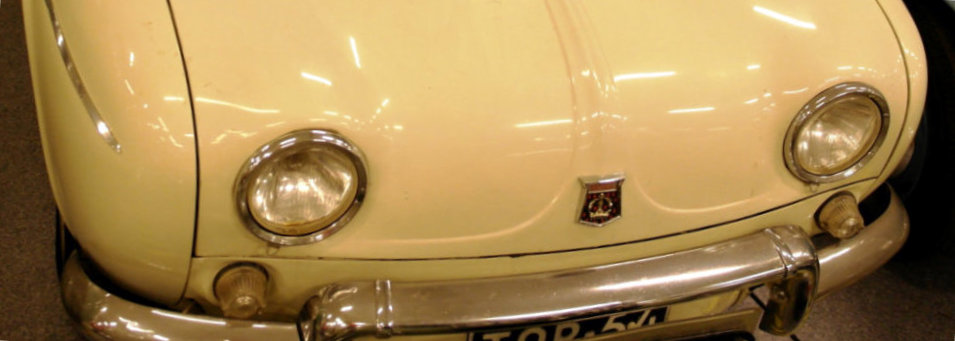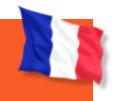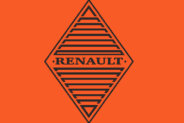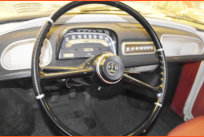



The Dauphine pioneered the modern European economy car

Renault Dauphine
Gordini - 65
Renault Dauphine is a rear-engined economy car
manufactured by Renault in a single body style — a three-
box, four-door sedan — as the successor to the Renault
4CV, with over two million units sold worldwide during its
production run from 1956 until 1967.
Renault marketed variants of the Dauphine, including a sport model, the Gordini, a luxury version, the Ondine, the 1093 factory racing model, and the Caravelle/Floride, a Dauphine- based two-door convertible.Conception
As Louis Renault's successor, and as Renault's chairman, Pierre Lefaucheux continued to defy the postwar French Ministry of Industrial Production — which had wanted to convert Renault solely to truck manufacture. Lefaucheux instead saw Renault's survival in automobiles and achieved considerable success with the 4CV, with over 500,000 produced by 1954. The Dauphine was born during a conversation with Lefaucheux and engineer Fernand Picard. The two agreed the 4CV was appropriate in its postwar context, but that French consumers would soon need a car appropriate for their increasing standard of living.Prototyping
Internally known as "Project 109" the Dauphine's engineering began in 1949 with engineers Fernand Picard, Robert Barthaud and Jacques Ousset managing the project. A 1951 survey conducted by Renault indicated design parameters of a car with a top speed of 110 km/h (68 mph), seating for four passengers and fuel consumption of less than 7 L/100 km (40 mpg-imp; 34 mpg-US). The survey indicated that women held stronger opinions about a car's colors than about the car itself (See below, Marrot at Renault). Engineers spent the next five years developing the Dauphine. Within the first year, designers had created a ⅛th scale clay model, studied the model's aerodynamics, built a full scale clay model, studied wood interior mockups of the seating, instrument panel, and steering column — and built the first prototype in metal. Having largely finalized the exterior design, testing of the prototype began at Renault's facilities at Lardy, France — by secrecy of night, on July 24, 1952. Using new laboratories and new specially designed tracks, engineers measured maximum speed, acceleration, braking and fuel consumption as well as handling, heating and ventilation, ride, noise levels — and parts durability. Engineers tested parts by subjecting them to twisting and vibration stresses, and then redesigning the parts for manufacture. By August 1953, head engineer Picard had an almond green prototype delivered to Madrid for dry condition testing — ultimately experiencing only five flat tires and a generator failure after 2,200 km (1,400 mi). Subsequently, Lefaucheux ordered engineers to test a Dauphine prototype directly against a Volkswagen Beetle. The engineers determined that noise levels were too high, interior ventilation and door sealing were inadequate and most importantly, the engine capacity was insufficient at only four CV (748 cc). The four-cylinder engine was redesigned to increase its capacity to 845 cc by increasing the bore to 58 mm — giving the car a new informal designation, the 5CV. By 1954, a second series of prototypes incorporated updates, using the older prototypes for crash testing. Lefaucheux followed the testing carefully — often meeting with his engineers for night testing to ensure secrecy — but did not live to see the Dauphine enter production. He was killed in an automobile accident on February 11, 1955, when he lost control of his Renault Frégate on an icy road and was struck on the head — by his unsecured luggage as the car rolled over. The Flins factory was renamed in his honor, and he was succeeded on the project by Pierre Dreyfus. A monument in Lefaucheux's memory is erected at the Saint-Dizier highway exit, Haute-Marne 52100. By the end of testing, drivers had road tested prototypes in real world conditions including dry weather and dusty condition testing in Madrid, engine testing in Bayonne, cold testing at the Arctic Circle in Norway, suspension testing in Sicily, weatherseal testing in then-Yugoslavia — with more than two-million kilometers of road and track testing. In December 1955, Pierre Bonin (director of the Flins Renault Factory) and Fernand Picard presented the first example to leave the factory to Pierre Dreyfus, who'd taken over the project after the death of Pierre Lefaucheux.Debut
Renault first officially revealed the model's existence to the press through L’Auto Journal and L’Action Automobile et Touristique in November 1955 — referring to it simply by its unofficial model designation "the 5CV". Advance press preview testing began on February 4, 1956, under the direction of Renault press secretary Robert Sicot, with six Dauphines shipped to Corsica. Journalists were free to drive anywhere on the island, while under contract not to release publication before the embargo date of March 1, 1956. The Dauphine debuted on March 6, 1956 at Paris' Palais de Chaillot with over twenty thousand people attending, two days before its official introduction at the 1956 Salon International de l'Auto in Geneva.Name
In addition to its internal project number, Project 109, the prototype had been called by its unofficial model designation, the "5CV" and Lefaucheux, Renault's chairman, often simply called it L' machine de Flins (the Flins machine), referring to the Flins factory where Renault would ultimately initiate its production. Renault considered the name Corvette for its new model, but to avoid a conflict with the recently launched Chevrolet Corvette instead chose a name that reinforced the importance of the project's predecessor, the 4CV, to France's postwar industrial rebirth. The final name was attributed to a dinner conversation at the l'auberge de Port-Royal, chaired by Fernand Picard, where either Jean-Richard Deshaies or Marcel Wiriath said "the 4CV is the Queen of the road, the new arrival can only be the Dauphine. Dauphine is the feminine form of the French feudal title of Dauphin, the heir apparent to the throne. Ironically, both Robert Opron and Flaminio Bertoni of Citroën had wanted to name the Citroën Ami6 the Dauphine, though by that time, Renault had registered the name.
1965
Engine 845 cc 4 cylinders Power 40 HP Top Speed 125 km/h Lenght 3,94 m Widht 1,52 m Weight 630 kg The collections Dauphine is in original condition.

Photos mainly by Matti Kreivilä. Historical facts and technical details of the vehicles provided by Wikipedia. Movies YouTube.



- Decade of 60's
- Austin 850 Pickup - 1962
- Chaika Tshaika 13 GAZ - 1962
- Citroen 2CV - 1961
- DKW Junior - 1961
- Fiat 1100 - 1963
- Ford Taunus 12M - 1961
- GLAS 1204 - 1963
- MG 1100 - 1964
- Moskvich 407 - 1961
- Nagetusch caravan - 1961
- NSU Printz 4 - 1961
- Opel Kadett A - 1964
- Panhard PL17 - 1961
- Peugeot 404 - 1962
- Renault Dauphine - 1965
- Simca Aronde P60 - 1960
- Simca 1000 - 1966















